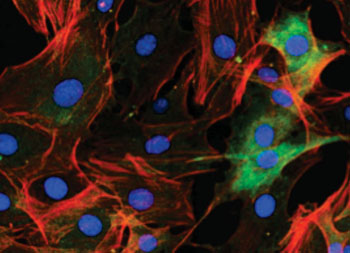Treating New Rheumatoid Arthritis Drug Target Would Not Increase Immune Suppression
By LabMedica International staff writers
Posted on 04 Jun 2015
Treatment directed at a newly identified drug target in rheumatoid arthritis (RA) would prevent damage to the joints while not increasing the immune suppression that is induced by the action of currently used therapies.Posted on 04 Jun 2015
Investigators at the La Jolla Institute for Allergy and Immunology (CA, USA) concentrated on the fibroblast-like synoviocytes (FLS), joint-lining cells that become activated during RA and mediate joint inflammation and destruction of cartilage and bone. During this study they identified the transmembrane tyrosine phosphatase enzyme RPTPsigma (receptor protein tyrosine phosphatase sigma), which is highly expressed on FLS cells, as a therapeutic target for FLS-directed therapy.

Image: In rheumatoid arthritis, fibroblast-like synoviocytes—specialized cells that line the inside of joints—invade and destroy the affected joint\'s cartilage. Ezrin, which plays in important role in cell adhesion and migration, is shown in green, actin in red, and the cells\' nuclei in blue (Photo courtesy of Dr. Karen Doody and Dr. Bill Kiosses, La Jolla Institute of Allergy and Immunology).
RPTPsigma is a member of the protein tyrosine phosphatase (PTP) family. PTPs are known to be signaling molecules that regulate a variety of cellular processes including cell growth, differentiation, mitotic cycle, and oncogenic transformation. RPTPsigma contains an extracellular region, a single transmembrane segment, and two tandem intracytoplasmic catalytic domains, and thus represents a receptor-type PTP.
The investigators reported in the May 20, 2015, online edition of the journal Science Translational Medicine that RPTPsigma was reciprocally regulated by interactions with chondroitin sulfate or heparan sulfate-containing extracellular proteoglycans in a mechanism called the proteoglycan switch and that the proteoglycan switch regulated FLS function.
Proteoglycans comprise a class of compounds consisting of polysaccharide (95%) and protein (5%).Proteoglycans and water form the ground substance of connective tissue such as cartilage and tendons, and are important in determining the mechanical properties of these tissues. Within tendons, for example, the ground substance provides friction that helps collagen fibers to adhere to one another, and also provide the spacing and lubrication that allows the fibers to slide past one another. Evidence also shows that proteoglycans can affect the activity and stability of proteins and signaling molecules within the extracellular matrix.
Incubation of FLS with a proteoglycan-binding RPTPsigma decoy protein inhibited cell invasiveness and attachment to cartilage by disrupting constitutive interaction between RPTPsigma and the heparan sulfate proteoglycan, syndecan-4. RPTPsigma mediated the effect of proteoglycans on FLS signaling by regulating the phosphorylation and cytoskeletal localization of ezrin. Ezrin is a cytoplasmic peripheral membrane protein that functions as a protein-tyrosine kinase substrate in microvilli. As a member of the ERM protein family, ezrin serves as an intermediate between the plasma membrane and the actin cytoskeleton. It plays a key role in cell surface structure adhesion, migration and organization, and has been implicated in various human cancers.
The administration of the RPTPsigma decoy protein blocked human FLS invasiveness in vivo and reduced severity of arthritis in the K/BxN serum transfer model of RA.
"Unfortunately, for around 40% of patients, immune-targeted therapies are not sufficient to bring them into full remission," said senior author Dr. Nunzio Bottini, associate professor of medicine at the La Jolla Institute for Allergy and Immunology. "If we could add a drug that acts on a different target without increasing immune suppression it could be very valuable. Even if your inflammation is completely under control with the help of current therapies—and they are excellent—the damage to the skeletal structure is not necessarily arrested in the long term because synoviocytes continue to cause damage, and although synoviocytes are considered the main effectors of cartilage damage in rheumatoid arthritis there is no therapy directed against them."
Related Links:
La Jolla Institute for Allergy and Immunology







 assay.jpg)





